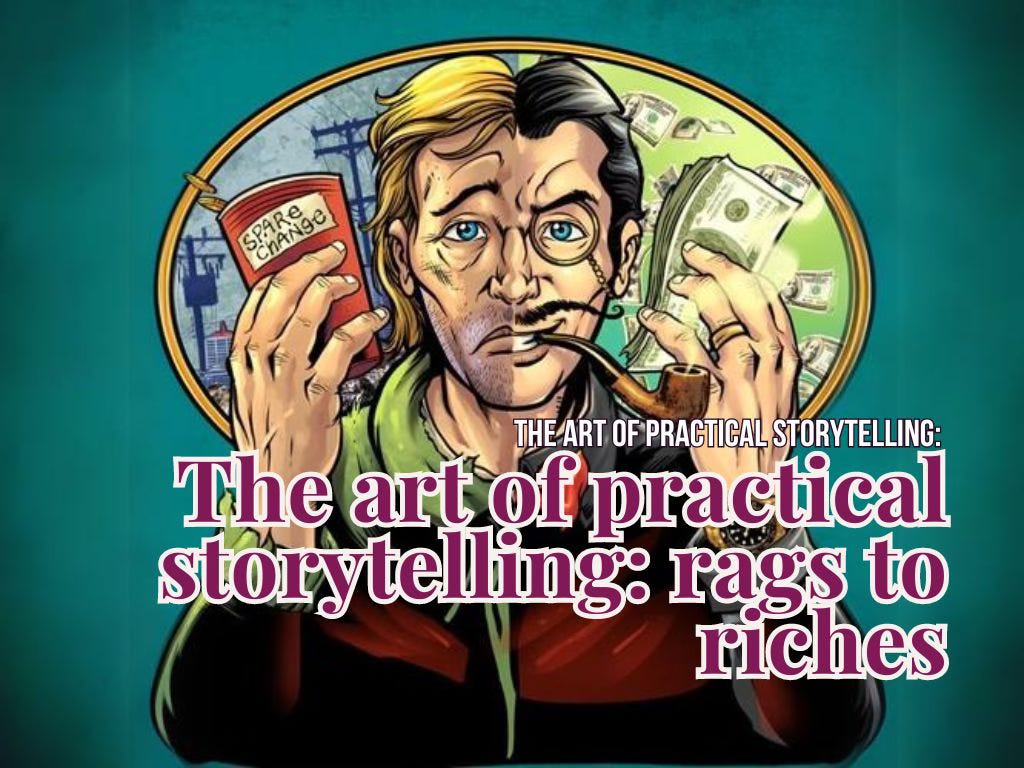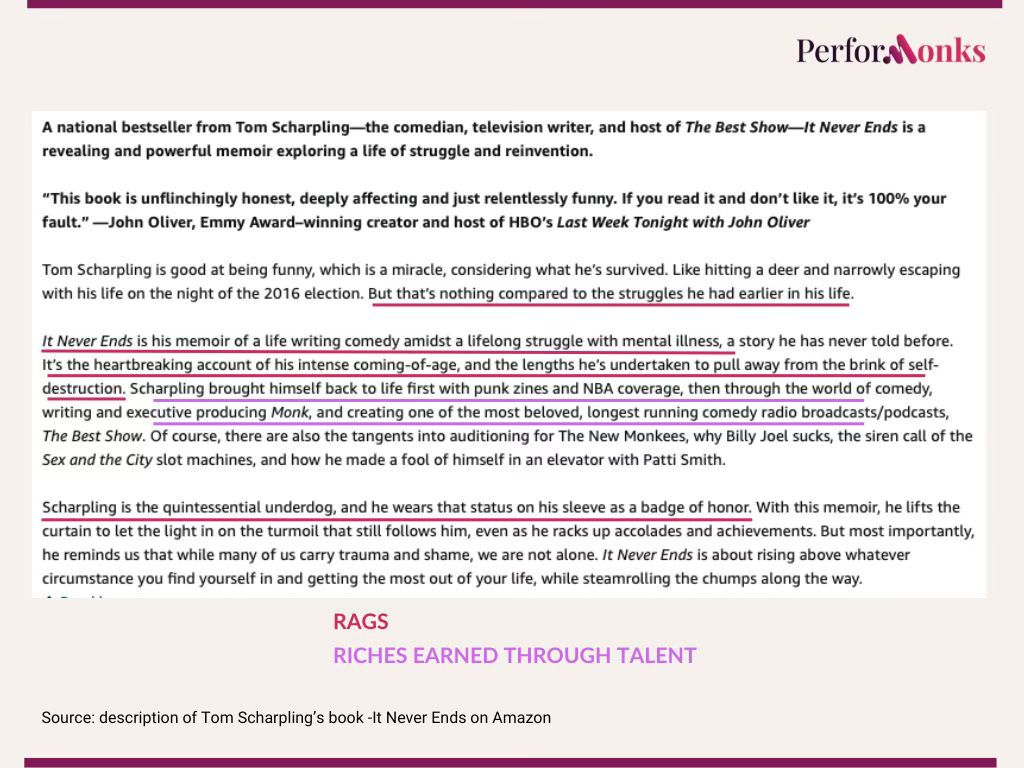The art of practical storytelling: rags to riches
Second story plot. Can be applied to build a personal brand or a startup. Three lessons I took from this plot.
Practical ideas on marketing and personal mastery they don’t teach in B-school. Performonks goes to 4,202 curious marketers and founders - join them here. Find The India Playbook here.
This is the fifth edition of The Art of Practical Storytelling series, in which I attempt to apply storytelling principles to marketing and daily corporate situations.
Each edition is like a Lego block that fits onto the previous ones. If you haven’t yet, try reading 1, 2, 3, and 4 before starting this one.
These seven-story plots are like potent blends of instant coffee perfected over centuries. Each blend awakens the impulses, insecurities, and aspirations that make us human.
The trick is to know which blend elicits which emotion.
Our second blend - Rag to Riches, makes ordinary people feel they can be extraordinary, too.
If Overcoming the Monster was about overcoming a huge, powerful, invincible enemy, Rags to Riches is about overcoming painful, shameful, and destitute beginnings.
Think Harry Potter, Pretty Woman, Oliver Twist, The Ugly Duckling, Ratatouille, The Shawshank Redemption, Slumdog Millionaire, and many more.
The ingredients

A diamond in the rough with a traumatised start:
The protagonist lives as an ordinary, insignificant person. They are in a state of lack—poverty, pain, and penury—and are traumatised by evil step-parents or guardians.
In a corporate setting, this could be
the great struggle before product-market fit,
a founder’s personal struggle that led to their starting a business,
overcoming a disability or a painful struggle in the case of a personal brand story.
A genie:
A magical figure suddenly appears and helps the protagonist shine. The Fairy Godmother, or the genie in Alladin.
In corporate life, this genie could be a mentor, a training program, a book you read or even a flash of personal insight.
The diamond shines, but briefly:
They go on to have some initial success. But this success is short-lived. When the clock strikes twelve, the diamond turns into coal once again—Cinderella dances with the Prince but turns back into a normal girl.
That’s because this small success was not earned. It was boosted by luck and the genie.
In corporate settings, a failure can be turned into a ‘learning moment,’ an opportunity to make a fresh start.
Full glory on own merit:
Turns out that they have been hiding extraordinary talent all this time.
Cinderella’s grace and kindness are evidenced by one glass slipper that does not disappear at midnight - that is her innate gift.
In Ratatouille, Remy has had a taste for high-brow food all along.
Alladin is kind to Abu, the monkey, whether he is poor and even when he is rich for a few days.
Having tasted ‘riches’ briefly, they pull themselves back up and recover everything they lost. In this process, they grow as people and learn to focus on what’s really important - not the riches but contributing to a cause greater than themselves.
Remy feeds people good food in Ratatouille. Cinderella and Alladin become good kings or queens, and so on.
Let’s see examples of rags to riches in marketing and corporate settings.
Startups
Startups and entrepreneurs leverage their own stories within this theme - the origin story of the company and the founder’s story become intertwined.
Traya: The founder, Altaf Saiyed, has spoken openly about his own fight with hair loss, which led him to research and try all possible solutions. Learnings from which he incorporated into Traya.
Jan Koum: Jay Koum is the Ukrainian founder of WhatsApp. When Facebook bought WhatsApp for $19 billion, Jan made a point of signing the deal in the same place where he used to collect his food stamps. [Link]
Narayana Murthy: The resilience and hard work it takes to build a new company is the ‘rags’ part of a story. The equivalent of the ‘Apple and Google were built in a garage’ narrative is common.
Here is an excerpt from Sudhar Murthy’s book on Infosys's early days. [The Indian equivalent of ‘we started in a garage' includes children, parents, and the whole community banding together. :-)]
Narayana Murthy’s1 self-image seems to have always been a rags-to-riches archetype. In the same book, his wife mentions that this is how he proposed marriage to her.
“I am 5'4" tall. I come from a lower middle class family. I can never become rich in my life and I can never give you any riches. You are beautiful, bright, and intelligent and you can get anyone you want. But will you marry me?”
Personal story
For personal storytelling, think about where you began in life. These are your metaphorical rags. What did you lack? Who or what troubled you? What made you want to go out into the world to discover your true talent?
Scott Galloway talks about growing up as the only son to a single mom who was a secretary. He did not have the money for college, nor did he have the grades to make it on a scholarship. His ‘genie’ turned out to be UC Berkeley, which admitted him on a quota. This single act, Scott Galloway says, changed his life path. Now that he is rich, he donated $4.4 million to the college for students from immigrant families. [riches and superpowers must be used for the greater good].
Kara Swisher did not grow up poor, but she grew up with an emotionally abusive stepfather. That gave her the superpower to stand up to bullies, to call a spade a spade, and to be ready with an answer in pressure situations—all this helped her in her profession as a pioneering tech journalist in Silicon Valley.
Tom Scharpling. Look at this book description for Tom Scharpling’s book description on Amazon. We can build our rags-to-riches story without behaving like victims.
Fun fact: The Buddha and Gandhi’s life stories are ‘riches to rags’.
Brands and content
Brands sell because they promise to get us a better deal— beauty, fitness, wealth, jobs, or marriage.
That’s why the rags-to-riches plot works perfectly when a brand wants to help us unlock a 'greater self' hidden within the 'normal self'. Like Nike’s Find Your Greatness campaign
Instamillionaire: Pocket FM is a hot new audio entertainment platform with 100 million app downloads. Their most successful program is Insta Millionaire. The story of a guy called Laxman or Lucky :-), who is inherently nice, gets cheated on by his girlfriend but then wins the lottery the same day and becomes an ‘instant millionaire’.
I have not heard the show, but I predict that Lucky will become an astute businessman and a generous, upstanding member of the community.
Keep Walking: Johnnie Walker’s ‘The Man Who Walked—Around The World’ is a well-known example of a rags-to-riches story. A bit of trivia - the film, > 6 minutes long, was shot in one uninterrupted take. It took 40 tries to get it right.
A lot has been said and written about the main protagonist in this story plot.
But few pay attention to the genie- the saviour. Or to the antagonists - the stepmother, the evil king or queen.
My three learnings from writing this piece are about them.
1) look out for the genies. They are all around us. Sometimes in disguise, sometimes in the open.
This is a clip from the movie, Sam Bahadur, based on the life of the chief of the army staff of the Indian Army during the Indo-Pakistani War of 1971.
In this clip, the Captain is the antagonist to the junior soldier. He follows the letter of the law and punishes the junior to salute him a thousand times for missing a salute earlier. Sam Bahadur, the genie, uses the officer’s draconian logic against him and says that an officer must also return a salute. I loved this!
2) Steer clear of the bullies and villains, even if it means letting go of opportunities.
3) Most importantly, if you are in a powerful position, can you be the genie to someone?
I will end this essay on that note.
Thanks for reading, and I’ll see you next week.
For my non-Indian readers, you may know Infosys. But you may not know that Sudha and Narayan Murthy are parents to Akshata - the wife of Rishi Sunak. Yes. That Rishi Sunak. If this isn’t a rags to riches story, I don’t know what is.






